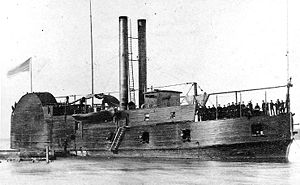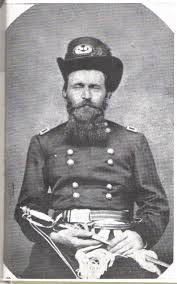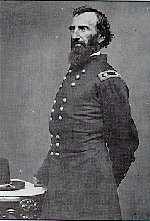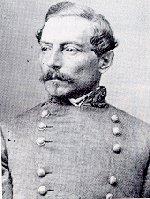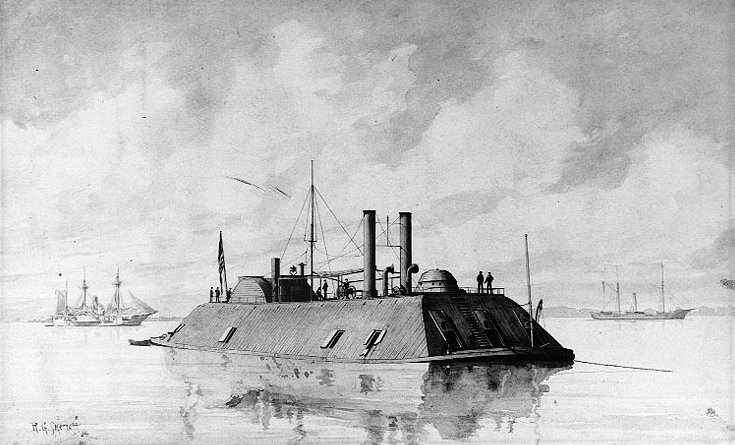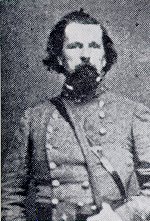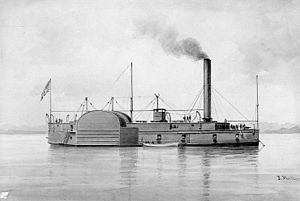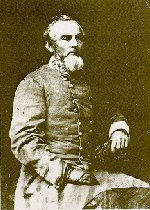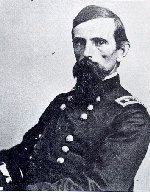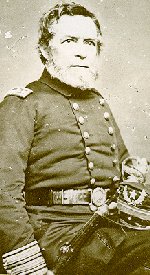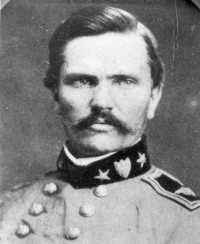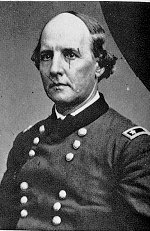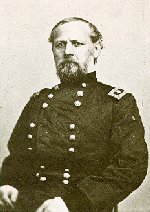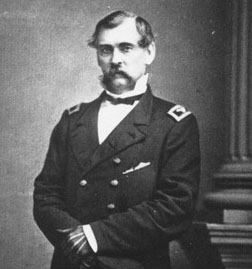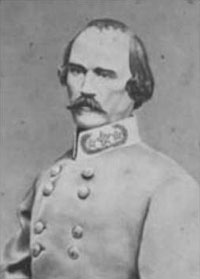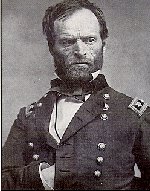| Date(s): |
Events: |
|||
| Dec. 1861--Jan. 1862 | Several Federal officers (Halleck, Grant, Buell, others) identify Forts Henry and Donelson as a key and vulnerable point in the Confederate line defending Tennessee and Southern Kentucky. Numerous reconnaissances by gunboats are made of both positions. [3, pp. 65-67; 4, pp. 23-25] |
| ||
| Jan. 10, 1862 | Demonstration toward Mayfield, Kentucky by elements of Grant's command. [3, p. 68; 7, pp. 164-165; 8, p. 68] |
| ||
| Jan. 16, 1862 | The Federal ironclad gunboat fleet is completed and commissioned. [3, p. 75] |
| ||
| Jan. 21-22, 1862 | Reconnaissance from Paducah, Kentucky, towards Fort Henry by elements of Brig. Gen. C.F. Smith's division. [7, pp. 183-185; 8, pp. 72--75] | |||
| Jan. 28, 1862 |
Brig. Gen. U.S. Grant and Flag Officer Foote propose to Maj. Gen. Henry Halleck that an
expedition be sent against Fort Henry; follow-up letters are sent on the 29th. [7, p. 189; 8, pp. 120-121]
CAIRO, January 28, 1862. Maj. Gen. H. W. HALLECK.Saint Louis Mo.: With permission, I will take Fort Henry, on the Tennessee, and establish and hold a large camp there. U.S. GRANT, Brigadier General. | |||
| Jan. 30, 1862 | Halleck orders Grant to
proceed against Fort Henry [7, p. 193; 8, p. 121]: SAINT Louis, January 30, 1862. Brig. Gen. U.S. GRANT, Cairo, Ill.: Make your preparations to take and hold Fort Henry. I will send you written instructions by mail. H. W. HALLECK, Major-General. |
|
||
| Feb. 3, 1862 | The
expedition begins. McClernand's division alone fills up almost all of
the available transports, but the fleet heads south anyway, escorted by
four ironclads (Essex, St. Louis, Carondolet, and Cincinnati) and three wooden gunboats (Conestoga, Lexington, and Tyler). [1, pp. 138--139; 3, p. 90--91; 4, p. 48; 7. pp. 197-198] McClernand lands four miles north of Fort
Henry. The transports return to Paducah to pick up the remainder of Brig. Gen. C. F. Smith's division. [1, p. 141; 8, pp. 126ff]
|
|
||
| Feb. 4, 1862 |
The
Confederates abandon the incomplete Fort Heiman on the west side of the
river, leaving only a small cavalry detachment to delay any Federal
advance. [2, p. 107; 4, p. 48; 6, p. 53; 8, pp. 137--138]
Confederate
General P.G.T. Beauregard, recently posted to the western theatre,
arrives at Bowling Green, Kentucky. [7, p. 213]
|
|
||
| Feb. 5, 1862 | Federal forces struggle through waterlogged terrain towards Fort Henry. Gunners at Fort Henry exchange a few shots with the USS Essex, which has gone forward to draw fire in order to get information about the range of the Confederate guns. [1, 141--142; 3, p. 97--100; 4, pp. 48-49; 7, p. 199] |
| ||
| Feb. 6, 1862 | Smith
lands two of his brigades on the west side of the river to attack
unfinished Fort Heiman, and discovers it has been abandoned. The
third brigade advances down the opposite riverbank towards Fort Henry. [1, p. 141; 8 p. 124] Confederate commander Lloyd Tilghman sends
the bulk of his garrison to Fort Donelson. [2, p. 108; 8, p. 140]
At 12:30 p.m. the Federal flotilla of four ironclads and three wooden steamers attacks Fort Henry. After slightly over an hour, Tilghman is reduced to only two working guns, and surrenders at 1:50 p.m. The fort had given a good account of itself, disabling one ironclad (the Essex) with a shot through its boiler. [1, 143--145; 3, pp. 101--109; 4, p. 49--50; 7, pp. 203-205; 8, pp. 122--124] (Cunningham puts the attack as starting at 11:00 a.m., but the report he relies on [8, p. 134] says the firing did not open until 12:30.) Grant arrives at the fort at 3:00 p.m. A small cavalry detachment is sent by McClernand in pursuit of the retreating Confederate garrison, and forces the abandonment of a field artillery battery as well as capturing 38 Confederate troops. [3, p. 110; 4, p. 50--51; 7, p. 205; 8, p. 129] Grant reports his success to Halleck [7, p. 206; 8, pp. 124]: HEADQUARTERS DISTRICT OF CAIRO, Fort Henry, February 6, 1862.
Fort Henry is ours. The gunboats silenced the batteries before the investment was completed. I think the garrison must have commenced the retreat last night. Our cavalry followed, finding two guns abandoned in the retreat. I shall take and destroy Fort Donelson on the 8th and return to Fort Henry. U.S. GRANT, Brigadier-General. Maj. Gen. H. W. HALLECK, Saint Louis, Mo.
|
|
||
| Feb. 6--10, 1862 | With the Tennessee River now open, a Federal gunboat squadron, consisting of the Conestoga, Lexington, and Tyler, under the command of Lt. Cmdr. S.L. Phelps, raids up the Tennessee River as far as Muscle Shoals. Two steamboats full of military stores are captured and burned (with quite explosive effects), and the steamer Eastport, being converted to an ironclad gunboat, is captured along with a large quantity of timber and iron plating intended for her construction. (The conversion of the Eastport into an ironclad ram is finished at Cairo, and she serves the Union on the western waters until April 15, 1864, when she strikes a mine in the Red River and has to be destroyed to prevent her capture by the Confederates.) [1, 148--149; 3, pp. 113--115; 4, p. 52; 7, pp. 221-222; 8, pp. 153--156] |
| ||
| Feb. 7, 1862 | Confederate
General A.S. Johnston, in command of Department #2 (encompassing most
of the Western Confederacy), orders Ohio-born Brig. Gen. Bushrod
Johnson to Fort Donelson to take command of the post. [4, p. 54; 7, p. 217-218; 8, p. 2, p. 358] |
| ||
| Feb. 8, 1862 | Brig. Gen. John B. Floyd arrives in Clarksville, about 30 miles from Fort Donelson, pursuant to orders received on the evening of the 6th. [3, p. 128; 8, p. 865] |
|
||
| Feb. 9, 1862 |
Brig.
Gen. Gideon Pillow, veteran of the Mexican War, arrives at Fort
Donelson, with reinforcements, to take command. Pillow's orders
are to hold out as long as possible, then retreat to Nashville. [3, p. 128; 7, p. 221; 8, pp. 867--868]
|
| ||
| Feb. 11, 1862 |
Brig.
Gen. S. B. Buckner's Division arrives at Fort Donelson from
Clarksville, having marched there from Russellville, Kentucky. [8, p. 328]
An informal council of war is held aboard Grant's headquarters boat, the New Uncle Sam. [7, pp. 227-228] | |||
| Feb. 12, 1862 | Federal troops begin to appear along the Fort Donelson perimeter. [1, p. 153; 3, pp. 137-138; 6, p. 55; 7, pp. 229-230] Plans
are set in motion to send Brig. Gen. Dan Ruggles north from New
Orleans (eventually arriving at Corinth) with about 5,000 men. It will
take nearly a month for all the troops to reach their destination. [8, p. 878]
| |||
| Feb. 13, 1862 |
Floyd
arrives at Fort Donelson with reinforcements, bringing the garrison
strength to just over 16,000 men. As the senior officer present,
Floyd takes command of the Confederate defense. [2, p. 116; 3, p. 138; 4, p. 58; 7, p. 234]
Grant's army, now increased to three
divisions (under Smith, McClernand, and Brig. Gen. Lew Wallace)
invests Fort Donelson. [2, p. 112, 118; 4, p. 58; 3, pp. 139-140; 7, p. 233]
McClernand sends a brigade forward to deal with a troublesome battery and is repulsed with some loss. [1, p. 156; 3, pp. 143-146; 4, p. 59; 7, p. 233; 8, pp. 172-173]
During the morning, the ironclad Carondolet duels with the Confederate batteries, but gets the worst of it. [2, p. 118; 7, p. 232-233]
Note:
The Confederate position is more extensive than just the fort
commanding the river. A lengthy perimeter defense has been
established around the earthen fort itself, enclosing the small village of Dover. [2, p. 119; 7, p. 236]
Overnight the temperature drops and significant snow falls. [7, p. 235]
|
|
||
| Feb. 14, 1862 | At about 3:00 p.m., Federal gunboats (the ironclads Carondolet, Louisville, St. Louis, and Pittsburg, plus the wooden gunboats Conestoga, Lexington, and Tyler) attack the fort, but after some initial success, are driven off, with significant damage to the fleet; Foote is wounded. The Federal fire was initially very effective, but as Foote closed the range his own guns began to overshoot the enemy, while the Confederate batteries became more effective. [1, pp. 160-162; 2, p. 120; 3, pp. 155-159; 4, pp. 60-62; 7, pp. 237-238] |
|
||
| Feb. 15, 1862 | The
Confederates attack McClernand and Wallace on the right of Grant's
line, in order to open an escape route to Nashville, and are briefly
successful, throwing the Federal right back and opening up a couple of
roads. Meanwhile, Grant, who was absent from the army conferring with
the wounded Foote when the attack began, returns and orders C.F. Smith
to attack the Confederate lines in his front (on the Federal left), and
Wallace and McClernand to retake the position on the Federal right.
Both attacks are successful and the Confederate position is doomed.
Confederate response to the day's fighting is unusual, to say the least. Although the plan
had been to cut their way out towards Nashville, the
Confederates withdrew back into their original perimeter at the end
of the day. However, Smith's attack seized high ground
overlooking the Fort itself, rendering the Confederate position
untenable. In an almost comic meeting at Pillow's
headquarters, the Confederate leadership demonstrates how
not to be a
soldier: After much discussion on whether or not to
attempt to escape to Nashville, Floyd and Pillow decide
upon surrender of the garrison. Declaring that they should not be taken
prisoner, both Floyd and Pillow escape across the river
toward Nashville. Col. Nathan Bedford Forrest, who will be a
thorn in the side of the Federals in the future, leads
his cavalry regiment, together with an unknown number of other ranks from the garrison, out of the trap. Brig. Gen. S. B. Buckner, the senior officer remaining,
communicates with Grant, to ask for terms, and Grant's early-morning reply has become legendary [1, pp. 164-175; 2, pp. 121-125; 3, pp. 166-181; 4, pp. 64-66; 6, pp. 57-58; 7, pp. 244-248, 253-256; 8, pp. 161]: HEADQUARTERS ARMY IN THE FIELD, Camp near Fort Donelson, February 16, 1862. SIR:
Yours of this date, proposing armistice and appointment of
commissioners to settle terms of capitulation, is just received. No
terms except unconditional and immediate surrender can be accepted. I
propose to move immediately upon your works.I am, sir, very respectfully, your obedient servant, U.S. GRANT, Brigadier-General, Commanding. General S. B. BUCKNER, Confederate Army. |
|
||
| Feb. 17, 1862 | Confederates begin evacuating Nashville, heading for Murfreesboro. [2, p. 133; 4, p. 67] Halleck
wires McClellan, "Make Buell, Grant, and Pope major-generals of
volunteers, and give me command in the West. I ask this in return for
Forts Henry and Donelson." [1, p. 188; 7, pp. 260-261; 8, p. 628]
Brig. Gen. Dan Ruggles, with troops from New Orleans, arrives at Corinth. [7, p. 320; 8, p. 891]
| |||
| Feb. 19, 1862 | President Lincoln signs Grant's promotion to Major General of Volunteers; Buell and Pope are promoted later. (This means that Grant out-ranks every other officer currently serving west of the Appalachians, except for Halleck.) [1, pp. 188-189; 7, p. 265; 11, p. xxiv] | |||
| Feb. 20, 1862 |
Because
of the defeat at Fort Donelson, the Confederate fortress at Columbus,
Kentucky, under the command of Maj. Gen. Leonidas Polk, is ordered evacuated. [8, pp. 893-894]
On
this day, General-in-Chief McClellan wires Brig. Gen. D.C. Buell, "I
hope to have Richmond and Norfolk in from three to four weeks." [7, p. 269; 8, p. 640]
| |||
| Feb. 21, 1862 | Portions of C.F. Smith's command occupy
Clarksville, Tennessee. [1, pp. 184, 189; 7, p. 276; 8, p. 648] Grant
re-organizes his increasing force into four divisions, under
McClernand, Smith, Wallace, and Brig. Gen. Stephen A. Hurlbut. [7, p.
275; 8, pp. 649-650]
|
| ||
| Feb. 24, 1862 | Brig. Gen. William Nelson's division of the Army of the Ohio arrives at Fort Donelson as a belated reinforcement. Grant orders Nelson upriver towards Nashville. [1, p. 189; 7, p. 278; 8, p. 662] |
| ||
| Feb. 25, 1862 | Nelson's Division occupies Nashville. [1, p. 189; 7, pp. 278-279; 8, p. 662] | |||
| Feb. 26, 1862 | Brig. Gen. Daniel Ruggles, commanding at Corinth, Mississippi, informs Gen. Beauregard that he has sent a small mixed force of infantry, artillery, and cavalry, to Pittsburg Landing, in order to observe the Tennessee River. [5, p. 69; 8, p. 909] | |||
| Feb. 27, 1862 | Buell believes his force at Nashville to be outnumbered and in danger of being attacked, and demands that Grant sends him reinforcements. Grant sends Smith's division, then proceeds to Nashville himself, where he has a tense conference with Buell. [1, pp. 191-192; see also 7, p. 280-281; 8, p. 942] |
|
||
| Feb. 28, 1862 | Johnston's column begins evacuating Murfreesboro. [5, p. 87] Confederates begin evacuating Columbus, Kentucky. [4, p. 94; 8, pp. 437-438] | |||
| March 1, 1862 |
Halleck orders Grant to proceed up the
Tennessee River as far as Eastport, Mississippi, to destroy railroad bridges. [8, p. 674]
Lt. William Gwin, commanding the Lexington and Tyler, disperses the small Confederate outpost at Pittsburg Landing. [1, p. 201; 4, p. 80; 5, p. 70; 6, p. 9, p. 75; 7, p. 316; 8, p. 435]
| |||
| March 3, 1862 | Halleck
complains to General-in-Chief McClellan that he has "had no
communication with General Grant for more than a week. He left his
command without my authority and went to Nashville. His army seems to
be as much demoralized by the victory of Fort Donelson as was that of
the Potomac by the defeat of Bull Run." [1, pp. 195-196; 4, p. 72; 6, p. 16; 7, pp. 302-303; 8, pp. 679-680] | |||
| March 4, 1862 | Halleck
further writes to McClellan, "A rumor has just reached me that since
the taking of Fort Donelson General Grant has resumed his former bad
habits." He then writes to Grant: "You will place Maj. Gen.
C. F. Smith in command of expedition, and remain yourself at Fort
Henry." [1, p. 197; 6, p. 16; 7, p. 303; 8, p. 682; 10, p. 3] Flag
Officer Foote reports that Columbus, Kentucky has been occupied by
troops under the command of Brig. Gen. W.T. Sherman. [8, p. 436] Halleck directs that the Tennessee River expedition be based out of Savannah. [6, p. 19; 11, pp. 21-22] | |||
| March 5, 1862 | Confederate Gen. Albert Sidney Johnston, with most of the troops from Nashville, arrives in Huntsville, Alabama. (Some of the troops go to Athens, Alabama, slightly west of Huntsville.) [5, p. 87; 7, p. 321] | |||
| March 8, 1862 | The 40th Illinois lands at Savannah, Tennessee. [5, p. 75; 6, p. 6] | |||
| March 10, 1862 | Halleck
receives a telegram from the Adjutant General in Washington: "By
direction of the President the Secretary of War desires you to
ascertain and report whether General Grant left his command at any time
without proper authority, and, if so, for how long; whether he has made
to you proper reports and returns of his force; whether he has
committed any acts which were unauthorized or not in accordance with
military subordination or propriety, and, if so, what." [1, p. 206; 6, p. 17; 8, p. 683] Johnston reaches Decatur, Alabama. [5, p. 88] Hurlbut's Fourth Division departs from Fort Henry for Savannah. [6, p. 13] | |||
| March 11, 1862 | Major General Henry Halleck's command is
expanded by the consolidation of the Department of
Missouri, the Department of Kansas, and much of the
Department of Ohio, thus putting Buell's Army of the Ohio
under his command. [1, p. 206; 7, p. 308; 10, pp. 28-29] Grant, incensed at his treatment by Halleck, asks to be relieved of his command "until I can be placed right in the estimation of those higher in authority." [1, p. 205; 6, p. 17; 7, pp. 304-305; 10, p. 30] Most of the Federal force has landed in the vicinity of Savannah. [6, p. 6] | |||
| March 12, 1862 | Smith orders Lew Wallace's division to occupy
Crump's Landing, slightly upriver and across from
Savannah. While getting out of a small boat on the way
back to his headquarters, Smith slips and severely
injures his leg. The wound becomes infected and
eventually is fatal (April 25, 1862). [1, pp. 212-213; 4, pp. 83-84; 5, p. 78;6, p. 7; 7, p. 310] Halleck wires Grant, "You cannot be relieved from your command. There is no good reason for it." [1, p. 205; 6, p. 17; 7, p. 305; 10, p. 32] |
|
||
| March 14, 1862 |
Smith
orders Brig. Gen. W. T. Sherman, now commanding the Fifth Division, to
destroy the Memphis and Charleston Railroad at Eastport, Mississippi.,
an effort that is thwarted by rain as much as anything else.
Before departing, Sherman suggests to Smith that a division be
sent to occupy Pittsburg Landing. [5,
pp. 81-82; 6, p. 9]
At about 11:30 p.m., Gen. Braxton Bragg, with 10,000 men from Pensacola, arrives at Bethel Station northwest of Corinth. [7, p. 319; 9, p. 11]
Halleck orders Buell to advance his army from Nashville to Savannah. [6, p. 22]
|
| ||
| March 15, 1862 | Halleck
replies to the March 10 telegram from the Adjutant General (in part):
"General Grant has made the proper explanations, and has been
directed to resume his command in the field. As he acted from a
praiseworthy although mistaken zeal for the public service in going to
Nashville and leaving his command, I respectfully recommend that no
further notice be taken of it. There never has been any want of
military subordination on the part of General Grant, and his failure to
make returns of his forces has been explained as resulting partly
from the failure of colonels of regiments to report to him on
their arrival and partly from an interruption of telegraphic
communication. All these irregularities have now been remedied." [1, p. 206; 7, p. 305; 8, p. 683-684] Halleck orders Buell's Army of the Ohio to
advance from Nashville to Savannah, to link up with Federal forces there. [10, p. 38]
Sherman's and Hurlbut's divisions begin to assemble at Pittsburg Landing, upriver
from Savannah. [5, p. 82; 6, p. 14; 8, pp. 23-24]
| |||
| March 16, 1862 | Buell's army begins to leave Nashville. [5, p. 112; 6, p. 22] | |||
| March 17, 1862 | Grant arrives at Savannah, Tennessee, to take command of the army assembling near there. At this point, the army consists of McClernand's First Division, Smith's Second Division (commanded by W.H.L. Wallace, due to Smith's injury), Lew Wallace's Third Division, Stephen Hurtlbut's Fourth Division, and Sherman's Fifth Division. The First, Second, and Third Divisions are veterans of Fort Donelson; the Fourth and Fifth Divisions are green as grass. [6, pp. 16-17; 7, p. 310] | |||
| March 18, 1862 | Buell's advance division, under Alexander McCook, reaches the vicinity of Columbia, Tennessee, to find the bridge over the Duck River burned. Buell remains at Nashville. [5, p. 113; 6, p. 44] | |||
| March 19, 1862 | Grant visits Pittsburg Landing for the first time. [6, pp. 30-32; 7, p. 311] | |||
| March 20, 1862 |
The divisions of W.T. Sherman and Stephen
Hurlbut begin to arrive in force at Pittsburg Landing. [7, p. 314]
Brig. Gen. S.A.M. Wood's brigade of Johnston's command, arrives at Corinth. [6, p. 82] Halleck writes to Grant (not received until the 22nd) [10, pp. 51-52]: SAINT LOUIS, March 20, 1862. Major-General GRANT, Savannah, Tenn.: Your
telegrams of yesterday just received. I do not fully understand you. By
all means keep your forces together until you connect with
General Buell, who is now at Columbia, and will move on Waynesborough
with three divisions. Don't let the enemy draw you into an engagement
now. Wait till you are properly fortified and receive orders. H. W. HALLECK, Major-General. | |||
| March 21, 1862 | Brig.
Gen. J. A. McClernand's First Division begins transferring from
Savannah to Pittsburg Landing. Because McClernand ranks Sherman,
this will place him in command of the entire encampment. [4, p. 108-109; 6, pp. 35-36] Smith, Buell, Lew Wallace, and McClernand are promoted to Major General of Volunteers. [7, p. 334] | |||
| March 22, 1862 | Gen. A.S. Johnston arrives at Corinth. [5, p. 90] | |||
| March 23, 1862 | The rest of Johnston's command begins to arrive at Corinth. [2, p. 145; 4, p. 97] | |||
| March 24, 1862 | Sherman leads an expedition from Pittsburg Landing to Monterey and Pea Ridge, about halfway to Corinth. [6, p. 33; 7, p. 330] | |||
| March 26, 1862 |
Brig.
Gen. Benjamin Prentiss arrives at Pittsburg Landing, and is given
command of the new Sixth Division, consisting entirely of green regiments. [1, p. 218; 4, p. 107; 6, p. 135; 7, p. 334]
Buell
reaches Columbia Tennessee, on the Duck River. The destroyed bridge is still not rebuilt. [5, p. 113; 6, p. 45; 7, p. 337] | |||
| March 29, 1862 | Widely scattered Confederate forces in the
west are consolidated into a single command, now called the Army of Mississippi, under
Albert Sidney Johnston, with P.G.T. Beauregard as his
second-in-command. Corps commanders are Polk, Bragg,
Hardee, and Crittenden (replaced by Breckinridge on the eve of battle). Total strength is about 40,000 men. [1, p. 216; 4, p. 118; 7, p. 338; 10, p. 370] Buell begins crossing the Duck River at Columbia, some 85 miles from Savannah, after taking nearly two weeks to repair the bridge. Nelson's division fords the river before the bridge is completed, followed by Crittenden's, then McCook's, then Thomas's (on April 2nd). [5, p. 114-115; 7, pp. 337-338] |
|
||
| March 31, 1862 | Approximately 51,300 officers and men are in Grant's six divisions at Pittsburg and Crump's Landings [6, p. 41; 10, p. 84] | |||
| April 1, 1862 | Sherman leads a small expedition to Eastport, Mississippi. [4, pp. 115-117] |
| ||
| April 2, 1862 | Johnston issues orders for an advance and attack upon the Federals at Pittsburg Landing; he wires President Davis that he has ordered the army "forward to offer battle near Pittsburg." [4, pp. 122-123; 10, p. 387] | |||
| April 3, 1862 |
The
Confederate Army of Mississippi, 44,000 strong, marches out of Corinth
for Pittsburg Landing. The plan is to make the 22 mile distance
in one day, and attack on April 4. [4, p. 123; 5, pp. 121-122; 6, pp. 98-100]
A patrol of the Fifth Ohio Cavalry captures a Confederate private in a skirmish a few miles south of Pittsburg Landing. [4, p. 129] | |||
| April 4, 1862 |
At 5:00 p.m., Johnston decides to reset the attack for April 5, due to the large amount of straggling in the army. [4, p. 123; 5, p. 124]
A heavy rain begins. [4, p. 126] Skirmishing
near the Union lines continues. Col. Ralph Buckland's brigade of
Sherman's Fifth Division, out in front of the encampment on a training
mission, gets in to a rather hot firefight with the First Alabama
Cavalry, then encounters Confederate artillery before retiring. [4, pp.
129-133; 5, pp. 124-125, pp. 133-135; 6, pp. 123-125]
On his way back to the Landing after conferring with Sherman, WHL
Wallace, and Lt. Col. JB McPherson, Grant's horse slips and falls,
pinning the general's leg, which is painfully contused. For the next
several days Grant gets about with great difficulty and no small amount
of pain. [1, p. 218; 4, p.133; 5, p. 139; 6, p. 126; 7, p. 348]
| |||
| April 5, 1862 (morning) |
Nelson's Division of the Army of the Ohio begins to arrive at Savannah. [1, p. 220; 5, p. 139]
Col.
Jesse Appler of the 53rd Ohio calls his regiment into line in response
to reports of Confederates near his camp. Sherman tells him,
"Take your damned regiment back to Ohio. There is no enemy closer
than Corinth." [1, p. 219; 5, p. 137; 6, p. 128] | |||
| April 5, 1862 | Sherman (at Pittsburg Landing) writes to Grant at Savannah [10, pp. 93-94]: PITTSBURG LANDING, April 5, 1862. General GRANT: Your
note is just received. I have no doubt that nothing will occur to-day
more than some picket firing. The enemy is saucy, but got the worst of
it yesterday, and will not press our pickets far. I will not be drawn
out far unless with certainty of advantage, and I do not apprehend
anything like an attack on our position. Yours,W. T. SHERMAN, Brigadier-General, Commanding. Meanwhile, Grant writes to Halleck [10, p. 94]: SAVANNAH, April 5, 1862. Maj. Gen. H. W. HALLECK, Saint Louis, Mo.: The
main force of the enemy is at Corinth, with troops at different points
east; also at Bethel, Jackson, and Humboldt are small garrisons. The
numbers at these places seem to constantly change. The
number of the enemy at Corinth and within supporting distance of it
cannot be far from 80,000. men. Information obtained through deserters
place their force West at 200,000. One division of Buell's column
arrived yesterday. General Buell will be here himself to-day. Some
skirmishing took place with our outguards and the enemy's yesterday and
day before. U.S. GRANT, Major-General. The
Confederate army is again unable to form up for an attack on the
designated day. In the late afternoon, an impromptu council of
war is held, at which Johnston declares that the army, finally in
position, will attack at dawn of April 6. "I would fight them if
they were a million," says Johnston. [2, pp. 156-157; 4, p. 138; 5, p. 128; 6, pp. 107-108] General Buell arrives at Savannah; it is late when Grant returns from Pittsburg Landing, so the two men do not confer. [5, pp. 140-141] Intermittent skirmishing occurs throughout the day along Sherman's front. [6, pp. 128-131] An extended patrol by several companies from Prentiss's Sixth Division, across Sherman's front, finds nothing. [6, p. 138] | |||
| April 6, 1862 | First day of the battle of Shiloh. Johnston's army is discovered by a Federal scouting party. Prentiss's and Sherman's divisions are badly mauled in the early fighting, but a line formed by Sherman, McClernand, Hurlbut, WHL Wallace, and Prentiss's remnants holds for several hours, giving Grant time to form a last line of defense along Dill Creek. Confederate General Albert Sidney Johnston is killed leading a charge in front of "the Peach Orchard." During the night Federal reinforcements (Lew Wallace and four divisions of Buell's Army of the Ohio) arrive. [1, pp. 222-242; 2, pp. 158-171; 4, pp. 143-328; 5, pp. 143-261; 7, pp. 356-382] | |||
| April 7, 1862 | Second
day of the battle of Shiloh. Grant and Buell each launch separate
counterattacks which slowly force the disorganized Confederate forces
back. [1, pp. 243-246; 2, pp. 173-175; 4, pp. 329-368; 5, pp. 262-292; 7, pp. 382-390] At about 2:30 p.m., Beauregard, now in command of the Confederate army, orders a retreat. [5, p. 290] | |||
| April 8, 1862 | Wood's Division of Buell's Army of the Ohio, together with a brigade from Sherman's Fifth Division and a battalion of Illinois Cavalry, march south from the battlefield to find the retreating enemy. At a fork in the road, Wood takes the left and Sherman takes the right. After pressing the enemy closely but being harassed by Confederate cavalry, Wood returns to his camp. Sherman encounters a well-laid trap at Fallen Timbers, courtesy of Confederate Col. N. B. Forrest, receives a bit of a bloody nose, and also retires to his camps. This ends the campaign. [4, pp. 373-375; 5, p. 296] |
